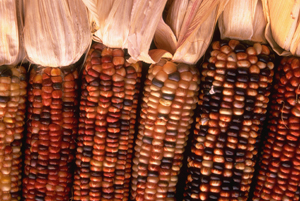
Very few purple plants are found in nature, so if you eat a true rainbow diet, this purple corn extract is a helpful and tasty addition.
by Joanne Henning Tedesco —
Among all the various colors of corn in the world — white, yellow, red, purple, brown, green and blue — a purple corn has been cultivated in South America for thousands of years. Generally grown in Peru, purple corn (frequently referred to as blue corn) is one of nature’s richest sources of at least six different anthocyanin antioxidants, more than even blueberries contain.
Purple corn has been used extensively as a staple food and a natural coloring dye. Anthocyanins (colored flavonoids) are water-soluble pigments present in the plant kingdom. They are the secondary plant metabolites responsible for the blue, purple and red color of many plant tissues. Recently, anthocyanins have been studied and reported to have antimutagenic, antimicrobial and anticarcinogenic properties.
More recently, purple corn extracts have been studied for their effectiveness in preventing obesity and amelioration related to hyperglycemia. Very few purple plants are found in nature, so if you eat a true rainbow diet, this purple corn extract is a helpful and tasty addition.
Purple corn extract is created by juicing the purple corn, and then at low temperatures, slowly evaporating off the liquid in the juice until a pure powder remains. Purple corn extract is a wonderful addition to smoothies, cacao/chocolate pastries, cacao/chocolate drinks, alchemical raw-food recipes and dressings.
It also makes a great face paint that kids will love. Simply use a little water on your hand, dip into the purple corn extract and paint their skin. It washes off with water.
Joanne Henning Tedesco is editor or AzNetNews.
Reprinted from AzNetNews, Volume 25, Number 2, April/May 2006.





January 20, 2013
Food, Nutrition and Diet, Health, Health Concerns, Organic, Weight issues